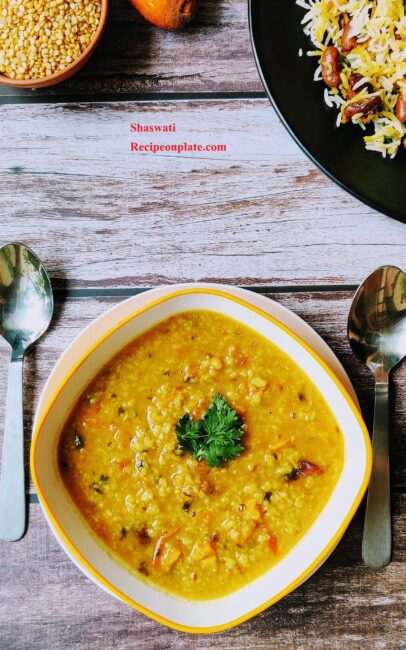Moong Dal or Yellow Split Gram or some people like to call it as Yellow Lentil is a type of pulses, which is a very common ingredient of side dishes in India.
Dal is a generic Bengali/Hindi word for Lentil. The same word dal refers to both the uncooked and also the cooked lentil.
There is a ongoing debate on whether Moong Dal is a lentil on not, lets not go to the debate and go ahead with the preparation and recipe of the food.
Lentils are most adaptable, sustainable and economical pulses that has lots of health benefits. As they have high fiber content and plant based proteins, they are easy to digest and helps to maintain good cholesterol and blood sugar levels.
Here Moong Dal recipe refers to the cooked Yellow Split Gram or so called Moong Dal curry.
There are various ways to cook this lentil, below one I found to be the tastiest of the bunch.
There are verities of dals and all of them have varieties of preparation method. It might get little confusing for people who are not used to these pulses and beans.
Some of my favorite dal curries are kali dal, vegetable dal, moong dal, urad dal, dal makhni, palak dal etc. Recipeonplate will come up with the recipes of all of them, so keep in touch.
Today I am sharing with you a simple and popular Moong Dal recipe.
It is a good combo with rice or roti or you can have it without any main dish as well. Lets move to the preparation of this versatile lentil recipe.

INGREDIENTS
1cup-240ml; 1tablespoon – 15ml ; 1teaspoon – 5ml;
- Moong dal (Yellow lentils) – 1/4 cup
- Cumin seeds – 1/2 tsp
- Dried red chili – 1 piece
- Bay leaves – 1 piece
- Cumin Powder – 1 tsp
- Turmeric powder – 1/4 tsp
- Coriander leaves – 1/4 cup
- Carrot – 1 medium size
- Tomato – 1 small size
- Ginger paste – 1/4 tsp
- Sugar – 1 tbsp.
- Ghee – 1 tbsp.
- Water – 2 cup
Equipment
- Normal Pressure Cooker
Notes
How to make Moong Dal
Step 1: Firstly we need to chop the tomatoes, corianders and carrots into small pieces. You should wash them before chopping.

Step 2: Add 2 tbsp. of oil on a preheated normal pressure cooker. Then add 1 dry red chili and 1 bay leave. Fry them for 1/2 minutes. It helps to extract the smell of the raw spices, which eventually enhances the flavor of our dish.
Step 3: Now add 1/2 tsp of cumin seeds into the pan and wait for splutter.
Step 4: At this point add chopped carrots on the oil and fry them for 3-4 minutes on low to medium flame.
Step 5: After that add chopped tomatoes and ginger paste into it. Roast for 1 -2 minutes on low flame.
Step 6: Now add the 1/4 cup of Moong dal (Yellow lentils) on it and fry for another 1-2 minutes. Then add 1 tsp of cumin powder and 1/4 tsp of turmeric powder into it. Stir them well.

Tips: Here you could also add roasted moong dal (yellow lentils) into the masala.
Step 7: Now add 2 cups of water in the pressure cooker and then wait for boiling.
Step 8: Put on the lid on and wait for one whistle, then switch off the gas.
Step 9: After 10 minutes or so check if the steam pressure inside the pressure cooker is neutralized, and then open the lid carefully. At this point add 1/4 cup of chopped coriander leaves and 1 tbsp. of ghee (clarified butter) into it. Stir them gently.
Step 10: Your Indian Style Moong Dal (Yellow lentils) curry is ready. Enjoy your dal with rice or roti. I hope this recipe will be helpful to you.
Our (recipeonplate) mission is to share recipes in easy words with proper step by step cooking instructions, pro tips and accurate measurements. So that it can help both pro, occasional and novice home chefs. If you like our effort and want to support us please share this recipe to your social media. We thank you for reading this recipe and hoping to see you again in our website.
Frequently Asked Questions
Which dal is high in protein?
All of the Lentils, Beans, and Pulses have plant based proteins in it. Among them Urad Dal (Black Lentil), Green lentils / split green gram(moong dal with a green layer of skin cover), red lentil / masoor dal have higher proteins than others.
Is Moong Dal protein or carb?
Each and every Dal (Lentils) is a good source of protein. Additionally moong dal has good fiber content as well which helps in digestion.
Can we eat Moong Dal daily?
Yes, you can include the moong dal into your daily diet.
I am an Indian and dal is the most common side dish for us. we consume dal on daily basis.
Is Moong Dal healthy?
Yes it is. Considering the food and nutritional value it is a really a sustainable pulse. The nutritional figures I have mentioned below is for yellow moong dal. Green moong, which is basically the same yellow lentil with its green cover is superior in nutritional figures.
Calories-348
Fat-1.2
Protein-24.5
Fiber-8.2
Carbs-59.9
Which dal is better moong or masoor?
That completely on personal preference, and choice of main dish. Like masoor is not so good combo with rotis, where moong is good combo with both rice and roti. Masoor dal has more plant based protein than moong and the list goes on.





[…] Read in English […]